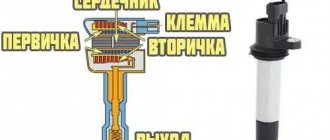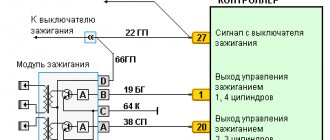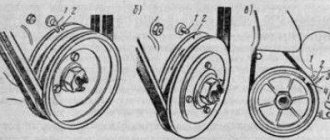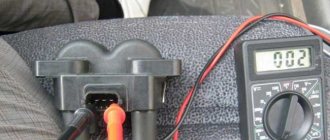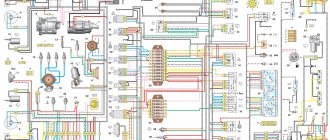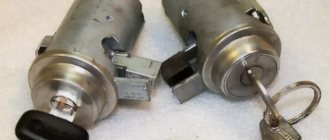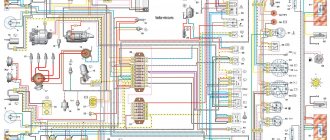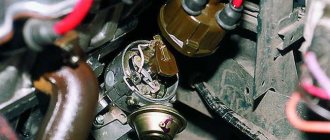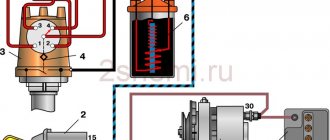Part two - the engine starts, but does not run satisfactorily.
Necessary preconditions: 1) the engine is in good working order; 2) the marks of the crankshaft and camshaft match; 3) gasoline and air enter the suction manifold from the carburetor; 4) there are no barriers to the escape of exhaust gases (no one’s “kind hand” stuck a potato into the muffler);
Step one: check for spark from the ignition coil. How to check it alone: 1. Gearbox in neutral; 2. pull out the central wire from the distributor and fix the metal tip of this wire at a distance of 5-7 mm from the ground (it is convenient to squeeze the insulating cap between the brake cylinder and the outlet tube); 3. turn on the ignition; 4. remove the block with wires from the starter relay and short-circuit the thick wires in it (perpendicular to each other) with a jumper - the starter will work; At this moment, a spark will (should) begin to beat rhythmically from the main wire. If there is no spark at all, read step two. If the spark is weak and begins to skip with a slight increase in the air gap (up to 10-12mm), read step six. In passing, I note that an indicator of the reliability of a starting spark is its continuity and length (and not color and thickness).
Step two: checking the timing belt Check if the slider rotates. To do this: remove the distributor cover and restart the starter using the jumper. If the slider does not rotate, change the timing belt. If it rotates, read step three.
Step three: checking the +12V power supply Check with a tester: is there voltage at terminal “B” of the ignition coil. If there is no voltage, then check the ignition switch, ignition relay, MB, wiring. If so, read step four.
Step four: checking the distributor (indirect) Remove the connector from the distributor with the ignition off, then turn the ignition on again. Use the test probe (the “crocodile” on ground) to poke into the middle terminal of this connector (green wire). At the moment the probe comes off, the coil should produce a single spark. If there is a spark, then the distributor (Hall sensor) is faulty; if not, read step five.
VAZ 21214 no spark
Hello forum users. There is a NIVA 2123 engine. 2123 ECU BOSCH. I don’t know which one exactly, I was only able to see this: There is no alarm on the car, no one has ever touched the immo, it’s as if it was off. The problem is this: it won't start. The starter vigorously turns the crankshaft, the check engine light goes out after it starts cranking. When you turn on the ignition, you can hear the fuel pump whirring, then the relay clicks. Everything seems to be as usual here. I tried to unscrew the spark plug - after driving with the starter it was wet.
I checked the spark, inserted the spark plug into 3 of the 4 explosives, there was no spark. That is, it turns out that all 4 lines do not work. The engine doesn't even try to catch, that is, there is no hope of a spark. I changed the DPKV - it didn’t help, the pump hums, there is no spark. True, I noticed that the new sensor differs from the old one: the shape of the nose, the old one is rectangular, and the new one is cylindrical. Is this critical? I don’t remember the numbers on them right now, but they have different markings. before the dot the numbers are different, but after the dot they are the same.
That is, the old aaa sensor. yyyyyyy and the new bbb. yyyyyyy. If necessary, I can tell you exactly their markings. Although I think if the sensor didn’t work, then the pump wouldn’t even pump gasoline. 1) is it possible to find out from that information what the ECU is and its true marking of the type 2123-14110. To make it easier to find what goes where and how in the future. 2) what to do now, how to look for the culprit, where to start?
VAZ 2114 no spark injector. repair
Quick transition Section for forum newcomers, novice diagnosticians and car owners Where to start? I am newbie! How can I start communicating, how can I ask questions? Where is my topic? Why was I banned? School of automotive diagnostics of Alexey Pakhomov. Fuel consumption. All about chip tuning and car diagnostics. Where can you get high-quality chiptuning (chip tuning). Chip tuning of domestic cars. Chip tuning of foreign cars.
Custom calibration of any ECM of foreign cars. Theoretical questions on internal combustion engines, diagnostics and chip tuning. Diagnostics and repair of domestic cars. Diagnostics and repair of foreign cars. Problems solved, cars made. Diagnostic practice. Exchange of experience Help section on a paid basis (Odo, SRS, etc.). Immobilizers, anti-theft protection. DC emulators (Emulators of a working catalyst).
Programs, equipment, tools and devices Programs, programmers, scanners, adapters, etc. Circuits, devices, adapters, equipment. Free software created by forum visitors. Spare parts and components for vehicle repair and maintenance. Aggregate tuning, boosting, sports technologies. SMS-Soft equipment for professional diagnostics and chip tuning. Trash (topics that violate the rules, are incorrectly formatted, etc.)
What to do if there is no spark at the injector? Possible problems
One of the most common reasons causing the inability to start a gasoline engine is the banal lack of spark at the spark plugs. Under such circumstances, there is nothing to ignite the combustible mixture on the compression stroke, and as a result, the engine refuses to work. Depending on what kind of power system the car is equipped with, it is determined exactly how to proceed to determine the exact cause of the lack of a spark and measures to return it. We’ll talk in more detail about this problem on injection engines today. Interesting? Then be sure to read the material below to the end.
Video diagnosing the causes of an uncertain cold start
The Chevrolet Niva will not start, we are looking for and eliminating the reasons.
There is no spark at the injector! Solution
Chevrolet Niva ignition coil
There is no spark on the injection engine. We are looking for a motive without a scanner.
FOUND. Chevrolet Niva
NIVA 65 thousand rubles for six months. No spark is the reason. Replacing the drive shaft oil seal. Buy NIVA
Won't it start?! Where to dig?! Look for “living” water for the “dead” Niva!
The situation on the road, the spark went out.
In the absence of a SPARK / DPKV crankshaft position sensor, check / major / major repairs on the VAZ 2115!
There is no spark at the spark plugs.
Checking for spark
Let's say your fuel-injected car has stopped responding to the ignition key and refuses to start. It is quite irrational to immediately complain about a malfunction in the ignition system. First of all, you need to make sure that it is the spark that has disappeared and not something else that has broken. To check spark plugs for the presence of the coveted “light”, you can resort to several procedures at once. Perhaps the most effective and simple ones are the following:
- The first method is a mass test. To implement it, you need to turn off the ignition, unscrew each spark plug in turn and, placing its body against ground (the metal body of the engine), try to start the engine;
- The second method is checking with a multimeter or a tester based on a piezoelectric element. This diagnostic option is quite similar to the method described above, except that the spark plug is applied not to ground, but to the contacts of the tester or multimeter. However, in this case there is no need to “turn” the starter; the spark must come from the devices themselves.
Fuel rail
On the ramp next to regulator 5 there is a regulating nipple 3. It is closed with a lid, which is unscrewed and then carefully pressed against the coil.
If fuel leaks, it means it ends up on the highway. But it is possible that the necessary pressure is not created. Reasons: clogged filter cylinder, pump malfunction, etc.
The pressure should be 350 kPa (3.5 bar). This is checked by unscrewing the coil and installing a pressure gauge. Reduce pressure before testing!
If fuel does not flow, pay attention to whether the pump operates when the key is turned to o. With the ignition on, the “cold” pump should run for 10 seconds.
Additional mounting block
Please note that fuse F2 and relay P4 are responsible for turning on the pump. And then there is the main relay P5, and all these elements are located in a block mounted on the same bracket with the ECM (see photo).
Even if the pressure is correct, the injectors may be clogged. Their wiring may also be damaged.
Case from practice
What happens if water gets into gasoline? Nothing in the summer. And in winter, the fuel system can become clogged with ice. All components are at risk, from the pump to the injector valves!
Fuel inlet filter
There is always a small amount of water in the fuel. If this amount is increased, the following will happen:
- The first start always goes smoothly;
- Therefore, after leaving the car in the parking lot, after 2-3 hours the owner will no longer be able to start the engine without repairs.
All of the above applies to any injection engine, including the VAZ-2123. And the “first candidate to start” will be the fuel filter. Under its bottom is a Chevrolet Niva, encased in aluminum (see photo). However, this is done on many cars.
Pumping up excess air
The smart book says that the engine may not start because the intake manifold is sucking in too much air. This means that it is necessary to check the fastening of all pipes. But not only.
Vacuum brake booster
A faulty VUT can be a source of “excess air”. The starter spins, the Chevrolet Niva engine does not start, but the reason, it turns out, lies in the brake system!
We won't look for anything. Let's make it simpler:
- The vacuum supply tube is also removed from the amplifier side (see picture);
- The hole in the pipe is closed with a finger and a test run is carried out;
- The engine starts, which means the cause has been found.
That's the trick. We wish you success!
Despite its apparent simplicity, defects in the air supply system are difficult to detect. Check the fit of the pipes to the fittings and the tightness of all clamps.
Causes of sparking problems
If there is no spark on the injector, and not, for example, on a carburetor or gear motor, you will have to try to identify the reasons for its loss. This is due to the fact that there are slightly more factors influencing spark formation in injection systems and they look more multifaceted. If we summarize the general list of possible causes of the problem, then it is worth highlighting the following most common ones:
- The spark plug or spark plugs are flooded with fuel - there is either no spark or very weak, the spark plugs themselves are wet;
- The spark plug or spark plugs are faulty - there is no spark at all, deposits on the contacts are usually black or white;
- The crankshaft sensor, ignition module, ignition coil, switch or distributor is faulty - there is no spark at all, the engine shows no signs of “life”, the injector does not work correctly;
- High-voltage wires have broken through or there has been a loss of contacts - one or two spark plugs do not work, the rest are fully operational;
- The injector electronics (ECU or wires) are faulty - the unit does not work correctly, there is no spark at all spark plugs;
- The injector nozzles are clogged - there is no spark at the spark plugs of specific cylinders, the injector is not working correctly.
Please note that for a complete and most accurate diagnosis, it is necessary to carry out several procedures at once:
- Naturally, check for a spark;
- Assess for the presence of the symptoms described above;
- Check for relevant errors on the dashboard or on-board computer screen;
- Check the potentially faulty unit (disassembly, cleaning, diagnostics with a multimeter, etc.).
If, based on the results of all diagnostic procedures, the problem is not identified, then, most likely, a visit to the service station cannot be avoided. Otherwise, it is quite acceptable to carry out repairs yourself, of course, if you have the proper skills, abilities and tools.
Checking the ignition distributor
If you suspect a malfunction of the breaker-distributor, you must carefully inspect its cover from the inside.
- If the cap is in order, then simply wash it with gasoline,
- If any cracks are found, the cover will need to be replaced.
The center carbon contact of the breaker is checked for sticking by lightly moving it with your finger.
The rotor insulation of the breaker-distributor is checked for breakdown as follows:
- Place the central high-voltage wire with a gap of 5-8 mm from the rotor electrode,
- After this, close and open the breaker contacts with your hand (the ignition must be turned on).
The appearance of sparks in the gap indicates a rotor malfunction that will need to be replaced.
Bringing the car back to life
As for why a spark disappears, everything is probably very clear. Now, it would not be amiss to consider the order of her return. The reality is that in most cases, getting the spark back is a simple matter and just involves carefully checking the broken car. To be more precise, to normalize sparking it is required:
- Firstly, check the spark on the injector using the method described above, make sure that it has disappeared, and, at least indirectly, try to determine the cause of the malfunction;
- Next, it is enough to assess the current circumstances and act based on them. As typical situations, we suggest considering solutions to the following problems:
- the spark plug is wet, the presence and strength of the spark are unimportant, the carbon deposits are correct (brick color) - wipe the part and screw it back in;
- the spark plug is wet (not always) and the carbon deposits are incorrect (white or black) - clean, dry the part and try to start the engine, if there is no result, change the spark plug and deal with problems in the fuel system (cleaning the injector, checking the ECU, etc.);
- the spark plug is wet, there is no spark at all, the color of the soot is not important - we try to change the part, if there is no result, we check the ignition system and the operation of the injector.
In principle, in theory there are no particular difficulties in repairs of this kind. Despite this, it often causes difficulties in implementation for inexperienced motorists. To solve these, you need to act in the order described above, but if something doesn’t work out, it’s better to turn to professionals at a service station. This approach to repairs will not only save time, but also guarantee trouble-free operation of the car in the future.
Niva won't start reasons 21214 injector
Like any other malfunction, a malfunction of the ignition system is unpleasant and untimely, but unlike others, it can cause a lot of trouble when trying to diagnose, that is, find out the cause of the breakdown and inoperability of this system. Today we’ll talk about the situation when there is no spark and the engine is not working properly. which one doesn't want to start. In this article, I will talk about the most likely reasons why the spark disappears and how to find the reason at home. The main signs of a malfunction in the ignition system are unstable engine operation (the engine stalls, the idle floats), poor starting or a complete absence of a spark on the spark plugs. If the spark is lost, it is necessary to establish exactly the reason why this happened, for this it is necessary to decide on the “circle of suspects”.
What is an ignition coil?
The coil is a pulse step-up transformer. It is she who ensures the conversion of low voltage, which is supplied to it from the battery or generator, into high voltage pulses.
Thanks to these impulses, a spark jumps between the electrodes of the spark plug, which ignites the working mixture in the cylinders.
Like any transformer, the coil consists of two windings (primary and secondary), a magnetic circuit and a housing.
The module is structurally somewhat more complex and includes two coils and a switch, but its operating principle is identical to the coil.
The main reasons why there may be no spark
- First of all, make sure that there is no dust, dirt, oil stains, etc. on the ignition system elements. If any of the above is present, take a rag and wipe everything thoroughly, or blow it out with compressed air, and then try to check the spark again and start the engine.
- The spark plugs are faulty (“flooded”, insulator burst, breakdown, etc.). Check the spark plugs individually and make sure there really is no spark. If there is no spark on all the spark plugs, then the reason is most likely not in the spark plugs, but in the coil or, for example, the starter. Read: how to check the starter here. If there is a spark, but it is weak or yellow, check the coil or BB wires.
- The problem is in high voltage wires (HV wires). This could be a break, a ground fault, or poor contact. Carry out a detailed inspection of the explosive wires, make sure that there are no cracks or fractures on their surface. Move the wires and try to start the engine, if the engine starts or at least tries, most likely the reason lies in the wires. Details on how to check BB wires.
- Malfunction of the ignition module or ignition coil. how to check the ignition coil here.
- The crankshaft sensor has failed, read here how to check.
- The problem is in the switch, distributor, incorrect clearance, burnt contacts.
- There is no contact on the ground wire or it is very bad.
- ECU malfunctions.
Methods for checking spark on spark plugs:
Details on how to check spark plugs.
Ignition system for Niva
Ignition problems lead to interruptions in engine operation, so it is necessary that the person fixing it has good knowledge and skills. The quality of the work done depends on this. In some cases, when there are no such specialists nearby, there is a need to replenish one’s own knowledge.
The ignition system can become operational with self-repair.
- Device
- Purpose
- System elements
- Peculiarities
- Malfunctions and solutions
